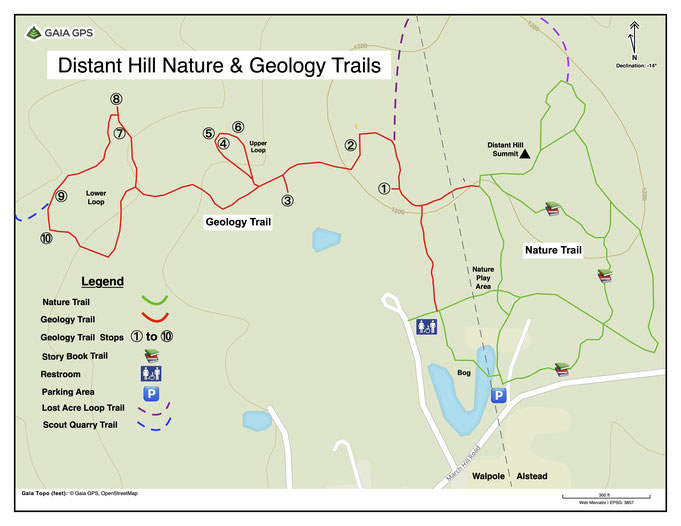Distant Hill Geology Trail
“The poetry of the earth is never dead.” - John Keats
The Geological History of Distant Hill
Distant Hill Geology Trail was built in 2017 to teach visitors about the unique geological history of Distant Hill. The Geology Trail has ten different rock outcroppings of geological interest spread along this three-quarter mile long hiking trail. Initially the Geology Trail was on its own, separate for the other trails at Distant Hill. But in 2020 we decided to connect the Geology Trail to Distant Hill Nature Trail.
In 2022 we added a six-foot wide tread of smooth gravel to the eastern half of the Geology Trail making it wheelchair and stroller accessible. We plan to gravel the remaining western half of the Geology Trail in 2023-24. Although too steep in spots to be truly a wheelchair accessible trail, it will make the traIl easier for walking visitors to navigate, and much of the "Lower Loop" might even be doable by power wheelchair users and strollers.
The 10 Stops on the Geology Trail

Stop 1
The Geologic History of Distant Hill
An outcrop of metamorphic rock with informational signs about the geologic history of the bedrock that makes up of Distant Hill.

Stop 2
Index Minerals & Metamorphic Grade
An explanation of the index minerals found in the exposed bedrock and how those minerals help determine the depth at which the rock formed.

Stop 3
Stretched Pebbles & Cobbles
Two outcrops of unique stretched pebble meta-conglomerate bedrock, flattened and stretched by the weight of miles of ocean-bed sediment.

Stop 4
Boudins & Boudinage
An outcrop containing long, oval rocks called boudins. Boudins collectively form what is referred to as Boudinage, a sausage-like rock formation caused by the stretching of a strong rock surround by a less stress-resistant rock.

Stop 5
Cross-bedding
An outcrop with an excellent example of cross-bedding, a sedimentary feature that shows the direction of the ocean currents at the time the sediment was originally deposited.

Stop 6
Bedrock Geology & Plant Occurrence
This stop explores the calcium-rich ‘Rattlesnake Knoll’. The calcium in the bedrock comes from ocean sediments high in precipitated calcite, making for a neutral pH and rich soils that allow for a number of rare plants.

Stop 7
Pegmatite Mine
A small mined outcrop of pegmatite, a coarse, crystalline-rich plutonic igneous rock historically mined in the area for crystals of minerals and gems such as feldspar, mica, quartz, tourmaline, and beryl.

Stop 8
Pegmatite Dome
A dome of pegmatite, the same type of rock found at Stop 8. This outcrop is still intact and has not been disturbed by mining as the previou pegmatite outcrop was.

Stop 9
Cliff & Talus Pile
A rock cliff with a talus pile/slope below. The pile was created by the effects of erosion, weathering and gravity on the cliff's rocks.

Stop 10
Turbidite
An outcrop with an example of a turbidite, a sudden undersea landslide composed of obvious layers of sediment from coarse gravel to fine-grained siltstone.
Distant Hill was listed as one of the Top 10 Places to Visit in New Hampshire!
Friends of Distant Hill (dba Distant Hill Gardens and Nature Trail) is a nonprofit,
tax-exempt organization under Section 501(c)(3) of the U.S. Internal Revenue Code.
Donations are tax-deductible as allowed by law. Tax ID# 84-3765898
or send a check via Snail Mail to:
Distant Hill Gardens and Nature Trail, 507 March Hill Road, Walpole, NH 03608


